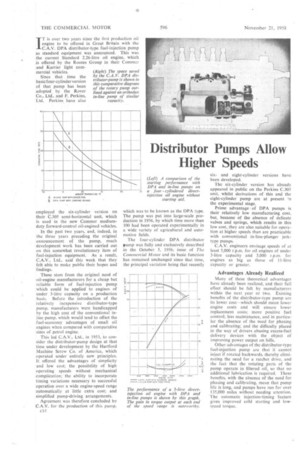Distributor Pumps Allow Higher Speeds
Page 52

If you've noticed an error in this article please click here to report it so we can fix it.
employed the six-cylinder version on their C.305 semi-horizontal unit, which is used in the new Commer mediumduty forward-control oil-engined vehicles.
In the past two years, and, indeed, in the three years preceding the original announcement of the pump, much development work has been carried out on this somewhat revolutionary item of fuel-injection equipment. As a result, C.A.V., Ltd., said this week that they felt able to make public their hopes and findings.
These stem from the original need of oil-engine manufacturers for a cheap but reliable form of fuel-injection pump which could be applied to engines of under 3-litre capacity on a production basis. Before the introduction of the relatively inexpensive distributor-type pump, manufacturers were handicapped by the high cost of the conventional inline pump, which would tend to offset the fuel-economy advantages of small oil engines when compared with comparative sizes of petrol engine.
This led C.A.V., Ltd., in 1953, to consider the distributor-pump design at that time under development by the Hartford Machine Screw Co. of America, which operated under entirely new principles. It offered the advantages of simplicity and low cost; the possibility of high operating speeds without mechanical complication; the ability to incorporate timing variations necessary to successful operation over a wide engine-speed range automatically at little extra cost; and simplified pump-driving arrangements.
Agreement was therefore concluded by C.A.V. for the production of this pump, c14 which was to be known as the DPA type. The pump was put into large-scale production in 1956, by which time more than 100 had been operated experimentally in a wide variety of agricultural and automotive fields.
The four-cylinder DPA distributor pump was fully and exclusively described in the October 5, 1956; issue of The Commercial Motor and its basic function has remained unchanged since that time, the principal variation being that recently
sixand eight-cylinder versions have been developed.
The six-cylinder version has already appeared in public on the Perkins C.305 unit, whilst derivations of this and the eight-cylinder pump are at present ;ri the experimental stage.
Primeadvantage of DPA pumps is their relatively low manufacturing cost, but, because of the absence of delicate valves and springs, which results in this low cost, they are also suitable for operation at higher speeds than are practicable with conventional in-line-plunger jerktype pumps.
C.A.V. engineers envisage speeds of at least 5,000 r.p.m. for oil engines of under 3-litre capacity and 3,000 r.p.m. for engines as big as those of 11-litre capacity or greater.
Advantages Already Realized
Many of these theoretical advantages have already been realized, and their full effect should be felt by manufacturers within the next year or two. Existing benefits of the distributor-type pump are its lower cost—which should mean lower engine costs and will ensure lower replacement costs; more positive fuel control; less maintenance, and in particular the absence of the need for phasing and calibrating; and the difficulty placed in the way of drivers abusing excess-fuel delivery devices with the object of improving power output on hills.
Other advantages of the distributor-type fuel-injection pump are that it cannot inject if rotated backwards, thereby eliminating. the need for a ratchet drive, and the fact that the rotating parts of the pump operate in filtered oil, so that no additional lubrication is required. These benefits, with the absence of the need for phasing and calibrating, mean that pump life is long, and pumps have run for over 135,000 miles without needing attention. The automatic injection-timing feature gives improved cold starting and lowspeed torque.












































































































